Digital SLR Cameras: K100D Super






Camera shake is caused by slight movement of the hand or body at the time of shutter release. The K100D Super incorporates the PENTAX-original Shake Reduction (SR) system, which counterbalances such movement to minimize the adverse effect of camera shake. This SR system offers shake reduction effects equivalent to two to 3.5 shutter steps.
The PENTAX-developed SR system takes beautiful images of
scenes previously
prone to camera shake
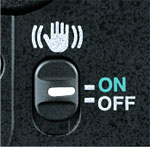 There
are some situations where camera shake is very likely, such as when using a telephoto
lens, shooting in the dark or evening without a flash, using extended exposures
for sunset scenes, or taking extreme close-ups with a macro lens. The PENTAX-original
SR system solves them all by detecting even the slightest level of camera shake
caused by your hand or body movement and effectively compensating for the movement.
Some images that appear to have no focal point over the entire image field are
actually the product of camera shake. With the K100D Super, however, you can
preserve exceptionally sharp, crisp images simply by repeating your regular photographic
routine.
There
are some situations where camera shake is very likely, such as when using a telephoto
lens, shooting in the dark or evening without a flash, using extended exposures
for sunset scenes, or taking extreme close-ups with a macro lens. The PENTAX-original
SR system solves them all by detecting even the slightest level of camera shake
caused by your hand or body movement and effectively compensating for the movement.
Some images that appear to have no focal point over the entire image field are
actually the product of camera shake. With the K100D Super, however, you can
preserve exceptionally sharp, crisp images simply by repeating your regular photographic
routine.
The SR system assures camera shake compensation of
two to 3.5 shutter steps
for worry-free handheld shooting
In the past, you had to either use a tripod or set a rather high shutter speed in order to prevent camera shake. The K100D Super’s SR system is designed to compensate for camera shake even in handheld shooting or at a relatively slow shutter speed. In fact, it assures you compensation effects equivalent to two to 3.5 shutter steps.*
* The degree of shake reduction effect may vary, depending on the lens used and/or the photographic conditions.
The magnet-driven image sensor shift mechanism
assures delay-free response with minimum power loss
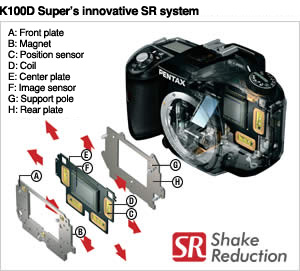
KThe K100D Super’s SR system features the PENTAX-developed image sensor shift mechanism, which uses a pair of gyro sensors to detect the amount and direction of camera shake and applies magnetic force to shift the image sensor at high speed along the center plate. Since it has few mechanical guides, it suffers the minimal loss of magnetic force and assures quick, stable response. Its simple structure also contributes to the downsizing and weight reduction of the camera body.
The in-body SR system allows
for
compact lens design
Since the entire SR mechanism is installed in the camera body, there is no need to incorporate any part of the shake reduction mechanism in a lens. That’s why PENTAX’s new digital-SLR-exclusive interchangeable lenses are designed to be remarkably compact and functional without sacrificing optical performance.
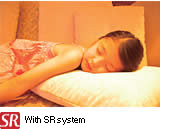
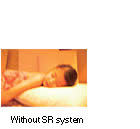
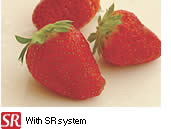

The
versatile SR system assures full compatibility
with all PENTAX lenses
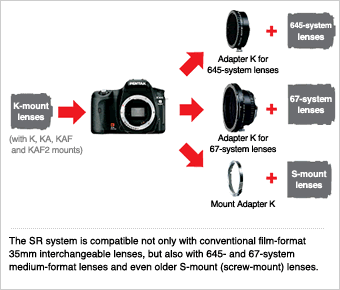 The
in-body SR system is the key to the K100D Super’s full compatibility with all
PENTAX interchangeable lenses. The SR system performs superbly, not only with
the new digital-SLR-exclusive lenses, but also with all other existing lenses,
as long as they can be safely mounted on the K100D Super.
The
in-body SR system is the key to the K100D Super’s full compatibility with all
PENTAX interchangeable lenses. The SR system performs superbly, not only with
the new digital-SLR-exclusive lenses, but also with all other existing lenses,
as long as they can be safely mounted on the K100D Super.

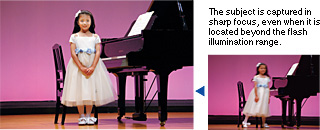
Since most cameras are programmed to select a slower shutter speed in the dark, even the slightest movement of the camera or subject can cause blurred images. The K100D Super, however, automatically pushes the sensitivity up to super-high ISO 3200 in the dark, allowing the use of faster shutter speeds to minimize the risk of blurred images.
The top sensitivity of ISO 3200 prevents blurred images
with high shutter
speeds
One effective solution to prevent blurred images is to raise the sensitivity and use a higher shutter speed. Since the K100D Super offers a sensitivity range of ISO 200 to 3200, you can effectively minimize the risk of blurred images in the dark. Higher sensitivities are also useful in situations when you want to avoid the use of flash illumination to preserve the prevailing atmosphere. Since the K100D Super’s image sensor is much larger than those featured in digital compact cameras, it assures beautiful, noise-free images, even when they are taken at higher sensitivities.
The auto sensitivity control mode sets the most appropriate sensitivity
to
the subject’s brightness level
Because it's a digital SLR camera, the K100D Super gives you the benefit of selecting the sensitivity for each image. When the auto sensitivity control mode is selected, the camera automatically adjusts the sensitivity level, up to the super-high sensitivity of ISO 3200, by detecting the subject’s brightness level. A single push of the OK button lets you instantly confirm the camera-selected sensitivity.
Note: When the cut-off level of the auto sensitivity control mode is set at ISO 3200, the standard sensitivity is set at ISO 800.
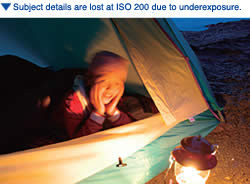

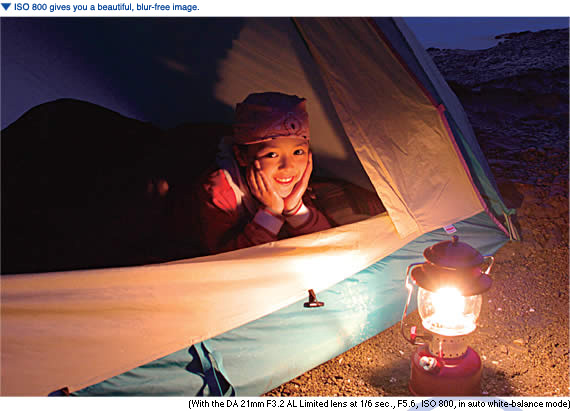
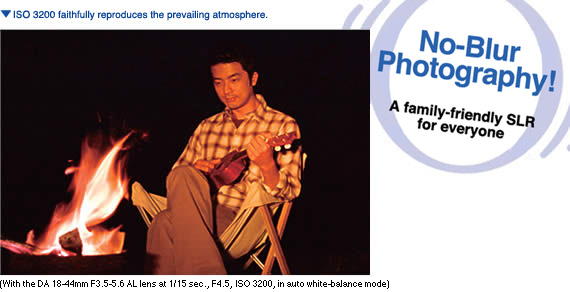

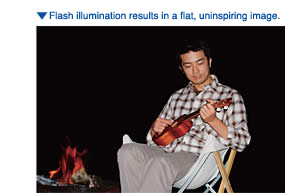
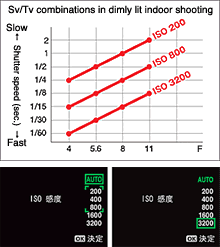
The reason why a higher ISO sensitivity allows
the use of a faster shutter
speed
Exposure is determined by a combination of sensitivity (Sv), aperture (Av) and shutter speed (Tv). The sensitivity is the image sensor’s ability to detect the incoming light; the aperture is the size of the lens’s diaphragm opening to let the light in; and the shutter speed is the duration that the camera’s shutter curtains stay open to let the light through. When the lighting condition is consistent, you can raise the shutter speed four steps by pushing the sensitivity up by four levels, from ISO 200 to ISO 3200.

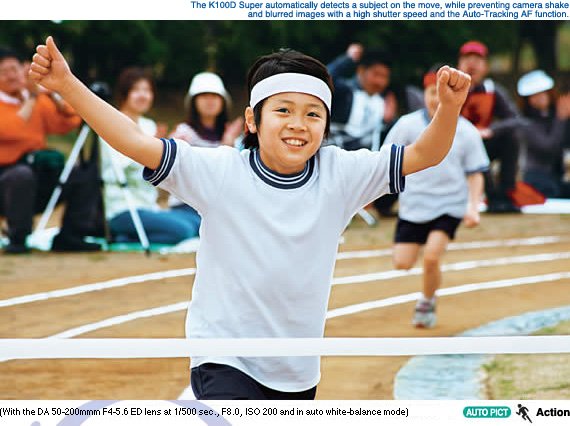
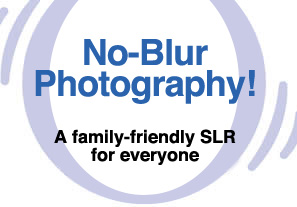
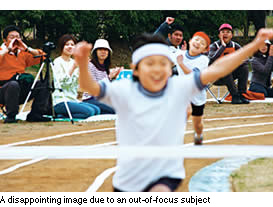
When you want to capture blur-free images of a child at play or unpredictable pet, simply select the Auto Picture mode on the camera’s mode dial. In this mode, the K100D Super detects the subject’s movement, maintains constant focus on the subject and selects a faster shutter speed — all automatically — to capture split-second shutter chances with great ease and accuracy. This is an especially convenient feature for shooting action-packed occasions, such as a school field day.
The camera detects the subject’s movement and
sets the Action mode to avoid
blurred images
Even though a child running a race and an active, playful pet are very interesting subjects, you may often find it difficult to focus sharply and quickly with these subjects. The K100D Super’s Auto Picture mode frees you from such worries by taking care of complicated operations for you. This sophisticated mode detects the subject on the move and automatically selects the Action mode to activate the Auto-Tracking AF function while setting a higher shutter speed. As the result, it freezes the subject’s movement completely to produce sharply focused images.


The K100D Super’s Dust Removal (DR) system features a well-designed two-step protection against dust and other minuscule particles, with a combination of the exclusive SP coating and the cleaning vibration of the SR system. This user-friendly system solves dust clinging — one of the most serious image quality-deteriorating problems inherent to digital SLR cameras — by effectively and thoroughly removing dust and alien particles from the CCD surface.

The SP coating and the vibration of the SR system
team up to shake dust off
the CCD image sensor
Applied to the front surface of the low-pass filter, the SP coating makes it extremely difficult for dust and other alien substances to adhere to the filter. Any dust still clinging to the filter is then shaken off as the CCD image sensor is vertically shifted at high speed. Named the DR system, this PENTAX-original two-step protection effectively keeps the CCD image sensor almost free of dust. What’s more, all the dust and other substances shaken off by the DR system fall onto a special adhesive sheet positioned beneath the SR unit, eliminating the possibility of dust drifting within the camera body. This user-friendly DR system assures sharp, clean images free of annoying dust spots.
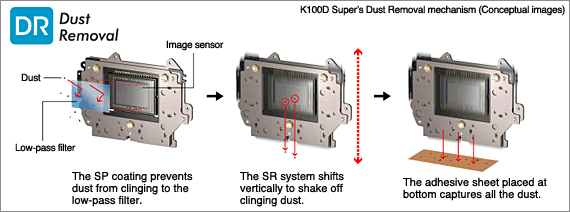

The Auto Picture mode sets the proper mode
with a press of the shutter release
button
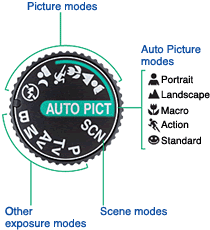 Simply
point the lens at the subject and press the shutter release button halfway down,
and the K100D Super not only selects the most appropriate shooting mode for a
given subject or situation, but also optimizes all related factors, including
exposure settings, AF mode, white-balance, saturation, sharpness, and contrast
levels, and noise-reduction.
Simply
point the lens at the subject and press the shutter release button halfway down,
and the K100D Super not only selects the most appropriate shooting mode for a
given subject or situation, but also optimizes all related factors, including
exposure settings, AF mode, white-balance, saturation, sharpness, and contrast
levels, and noise-reduction.
![]()
The camera adjusts contrast and saturation levels to create images with beautiful,
healthy skin tones. The subject’s hair appears sharp and lively, while the background
is blurred gently and beautifully.
![]()
The camera adjusts saturation and contrast levels to bring out rich shades of
flowers and other intriguing subjects.
![]()
The camera sets a smaller aperture than usual to expand the in-focus range across
the entire image field, while raising saturation, sharpness and contrast levels
to produce well-defined scenic images.
![]()
When the camera detects a subject on the move — such as a child running a race
or high-spirited pet — it automatically switches to this mode to freeze the action
and capture sharply focused images of the active subject. (Refer to the Declaration 3 section for more details.)
![]()
This all-purpose mode produces high-quality images with ordinary visual effects
in almost all applications, including casual snapshots.
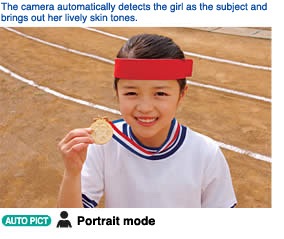
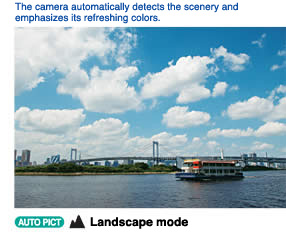
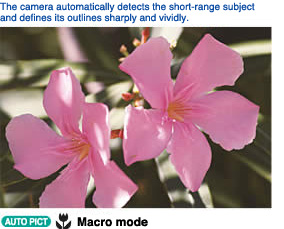
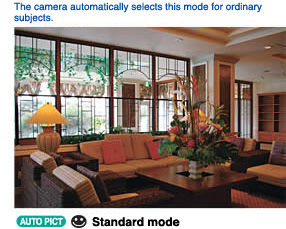
The Picture modes
assure automatic convenience in demanding situations
When you already know the subject, you can select one of six Picture modes. The Night Scene Portrait and Standard Flash-off modes in particular are designed to make highly advanced, complicated exposure techniques simple and automatic for everyone.
The subject is beautifully exposed with flash illumination, while the background retains the prevailing atmosphere. This mode is designed to produce striking night-time portraits with minimal digital noise.
The camera’s auto pop-up function is turned off to prevent flash discharge, while reproducing the prevailing atmosphere using ambient light.
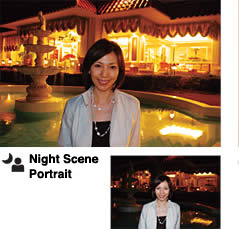
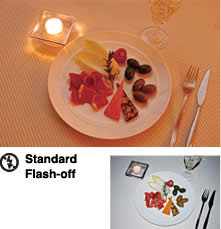
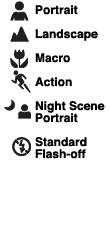
The Scene modes
deliver eight distinctive, professional-standard visual effects
Some subjects or scenes may demand completely different techniques and skills
rarely used in day-to-day photography. The K100D Super is equipped for such special
occasions, with eight distinctive Scene modes available to simplify and automate
professional-standard techniques. The desired Scene mode can be easily and instantly
selected using the mode palette on the LCD monitor.
Note: The built-in auto pop-up flash is turned off in the Night Scene, Sunset, Candlelight and Museum modes. Use of a tripod is recommended when the SR mode is not activated.

The AF mode is automatically switched
to accommodate the selected shooting
mode
When the Action mode (in the Auto Picture and Picture modes) or the Kids mode (in the Scene modes) is selected, the K100D Super’s AF mode is automatically switched to AF Continuous to assure constant focus on the subject as long as the shutter release button is held at the half-depressed position. With all other Auto Picture, Picture and Scene modes, the camera sets the AF Single mode to lock the focus at the initial focal point, which can be maintained by holding the shutter release button at the half-depressed position.
Conventional exposure modes
enhance the freedom of creativity and individuality
Programmed AE mode (P): The camera automatically sets the aperture and shutter
speed in relation to the subject’s brightness level.
Shutter-Priority AE mode (Tv): When the user selects the desired shutter speed,
the camera automatically sets the proper aperture to assure optimum exposure
on the subject. This mode is useful when you wish to freeze split-second action
with a fast shutter speed, or stretch the subject’s movement across the image
field with a slow speed.
Aperture-Priority AE mode (Av): When the user selects the desired aperture, the
camera automatically sets the proper shutter speed to assure optimum exposure
on the subject. This mode comes handy when you wish to control the depth of field
(or in-focus range) to add a creative touch to your image.
Metered Manual mode (M): The user selects both the aperture and shutter speed
manually to experiment with varying exposure levels for extraordinary, eye-catching
visual expressions.
Bulb mode (B): This mode is used to keep the shutter open for a desired length
of time in extended-time applications to capture dramatic images of fireworks
and nightscapes.
Versatile 11-point wide-area AF system
to capture all subjects in sharp,
crisp focus
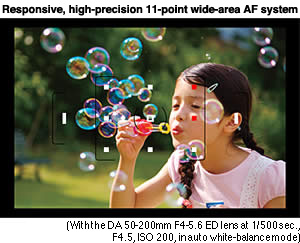
The K100D Super incorporates a sophisticated 11-point auto focus system. Nine middle sensors are cross-shaped and aligned in a square pattern to detect the subject with extreme precision, regardless of its size or shape. It even captures off-center subjects in sharp focus, giving you greater freedom in image composition. Manual AF sensor point selection is also available to accommodate more specialized applications. The AF sensor point indicator helps you identify the in-focus point by superimposing the selected sensor in red.
Large-format CCD image sensor and
high-performance imaging engine to
assure
true-to-life image reproduction

The K100D Super features a large CCD image sensor (23.5mm x 15.7mm). Coupled with the fine-tuned imaging engine, it delivers natural, true-to-life high-resolution images with minimal noise.
A choice of finishing touch
to assure desired color renditions
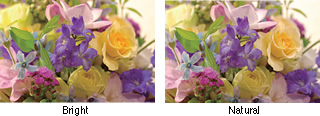
The K100D Super offers you a choice of two finishing touches: “Bright” to emphasize vivid colors for immediate printouts; and “Natural” to produce subdued colors and subtle shades for retouching purposes.
Three white-balance control modes
to accommodate different light sources
Proper white-balance control is essential in digital photography to reproduce pure-white areas of your subject faithfully in the resulting image. In addition to the user-friendly auto white-balance control mode, the K100D Super offers the preset mode to accommodate eight different light sources, and the manual mode for more minute adjustment.
High-speed shutter to freeze the subject’s movement
and avoid blurred images
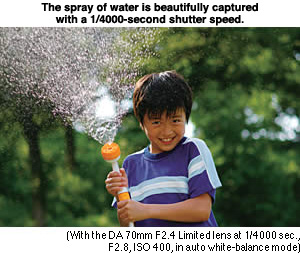
The K100D Super provides a 1/4000-second top shutter speed of to freeze fast-action subjects. This high shutter speed also allows you to open up the aperture to throw the background completely out of focus for more creative, eye-catching visual effects.
User-friendly self-timer and functional remote controller
for extra flexibility
and versatility
In addition to a conventional 12-second-delay mode, the K100D Super’s self-timer offers a two-second-delay mode that locks the mirror at the swing-up position to prevent camera shake at a shutter release. An optional remote controller lets you release the shutter from a distance.
High-speed advance mode
to capture the decisive moment in a sequence of images
The K100D Super features consecutive recording of up to five images (at Best image quality in JPEG format) at a speed of approximately 2.8 images per second, letting you capture a sequence of images and select the best one afterwards.

Sophisticated 16-segment multi-pattern metering
to assure proper exposure
under varying lighting conditions
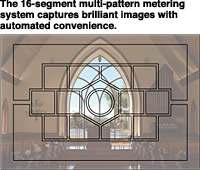
The K100D Super incorporates an advanced multi-pattern metering system, which divides the image field into 16 sections and comprehensively evaluates the metering data from them while integrating all affecting factors, including the subject’s distance, to determine the optimal exposure settings. Thanks to this user-friendly system, you are almost always assured of getting your expected result, even under complicated or confusing lighting conditions, such as a complex pattern of highlights and shadows or extremely backlit situations. The K100D Super also offers the conventional center-weighted metering mode and the pinpoint spot metering mode, which measures a mere 2.5 percent of the entire image field to accommodate more specialized applications.
AE lock for instant memory of the exposure settings
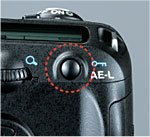
When the K100D Super is set to one of the auto-exposure modes, a single press of the AE-L/key button memorizes the current exposure settings. Since this data is preserved even after you change a camera angle or zoom the lens, you can capture the subject with the intended exposure level without readjusting the exposure settings. When pressed in a manual-exposure mode, this button sets the optimum combination of aperture and shutter speed to assure proper exposure without delay.
Exposure compensation for simple,
speedy exposure adjustments
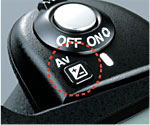
This function lets you easily and quickly react to changing lighting conditions. While pressing the ±/Av button, turn the select dial to set the desired exposure compensation value to create a different atmosphere for your image.
Auto bracketing
for three different exposures of the same subject
The auto bracketing function lets you capture the same subject or scene at three different exposure levels (at 1/2EV or 1/3EV steps, within the range of ±2EV), and lets you select the best shot later. Take full advantage of this useful function in many different situations, because the K100D Super allows you to delete unwanted images at any time and with great ease.

A wide-view LCD monitor
for comfortable group viewing

The large, high-resolution 2.5-inch color LCD monitor features a wide-view design to assure a clear view of the on-screen image from approximately 140 degrees both vertically and horizontally, making it easy for a family or group or to enjoy the just-captured images together. It also offers a 15-step brightness control function, making it easy to set the most desirable brightness level for comfortable monitor viewing.

Nine-image display
This function displays thumbnails of nine different images simultaneously. Thanks
to the extra-large screen, each thumbnail can be used for reliable, at-a-glance
visual reference. A slide-show function is also available for a quick tour of
captured images.
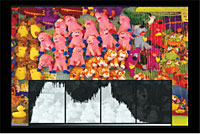
Histogram
This function offers a graphic display of exposure levels during playback. Even
histogram distribution suggests correct exposure. It also displays an overexposure
warning on the screen.

12X zoom display
During playback, you can easily and instantly magnify the just-captured image
up to approximately 12 times on the screen. This allows you to check the subject’s
focus, skin textures and expressions in great detail.
Digital filters for quick,
effortless retouching of recorded images
The K100D Super comes equipped with a set of digital filters that let you add distinctive visual effects to captured images. Since the original images remain untouched, you can experiment with these filters at will: creating visual effects similar to those of soft or color filters in film photography, changing the image’s overall bright level or the subject’s proportions, or even combining several filters to produce an intriguing, eye-catching effect.
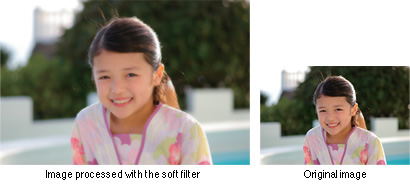
Soft
This filter creates a soft-lighting effect similar to that produced by a soft-focus
lens, enveloping the subject with a gentle light while retaining the clear outline
of the subject. The degree of the soft-focus effect can be shifted in three levels.
This filter converts a full-color image to monochromatic for creative, artistic expressions.
This filter creates a nostalgic, old-fashioned atmosphere.
This filter makes the subject appear broader or narrower by altering the vertical or horizontal proportions of the image.
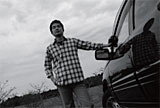
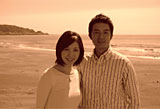

Color
 This filter offers a choice of 18 different color variations (six basic colors
with three shades each) to change the overall color scheme of your image.
This filter offers a choice of 18 different color variations (six basic colors
with three shades each) to change the overall color scheme of your image.
Brightness
This filter lets you adjust the image brightness in 16 steps (or ±8 steps) to
compensate the exposure level of recorded images. It is very useful when making
prints by connecting the camera directly to a printer.
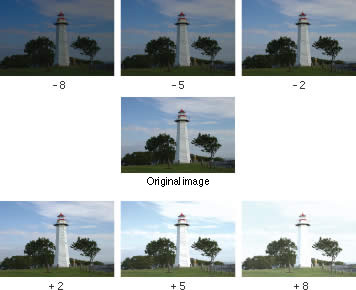
PC connection

The K100D Super can be connected to a personal computer via a USB2.0 (HI-SPEED) interface. By installing the set of software included on the accompanying CD-ROM on your computer, you can perform a variety of post-shooting operations with great ease and efficiency, including data transfer, image browsing/filing/editing and RAW-data development and processing.
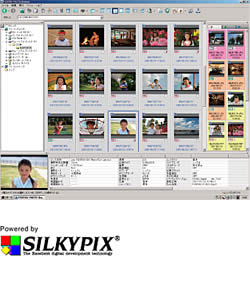
This software lets you speedily transfer images captured by the K10D Super to your personal computer, and edit and view them on the computer screen. Thanks to its high display speed, you can view and file a large number of images with great efficiency. It also offers a host of user-friendly functions, including confirmation of photographic data, change of file formats, and continuous playback (slide show).
•Speedy transfer of recorded images to a PC
•Thumbnail display in four different sizes
•Instant preview of a selected image
•Detailed image data display, including Scene-mode name
•A variety of image file editing functions
•Extraction and filing of RAW data in JPEG format
•Conversion of image data format to Adobe DNG
•Image-rotation, image-magnification and slide-show functions
•Automatic image-quality compensation function
•Simple print function
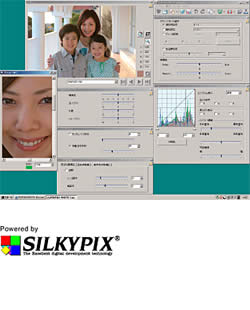
This software not only processes undeveloped RAW data, but also offers a wide variety of image-editing functions on a PC. Featuring SILKYPIX (developed by Ichikawa Soft Laboratory) as its image-development engine, it assures faster data processing speed and better operability than the previous version. It also performs various image-editing and data-manipulation functions without requiring additional retouching software.
•Display of RAW-data files
•Development and filing of RAW data in JPEG and TIFF formats
•Simplified image editing, with sensitivity, brightness, saturation, contrast
and outline controls
•Gradation control using a tone curve
•Histogram display, with over- and underexposure warnings
•White-balance control using a gray point
•Direct printing of RAW-data files
•Noise-reduction, peripheral-brightness-control, distortion-compensation
and chromatic-aberration-compensation functions
•Image compensation for digital shift
Direct printing
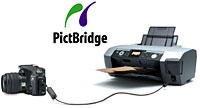
Using the included USB cable, you can connect the K100D Super directly to a PictBridge-compatible printer for PC-free printing. By assigning the images as DPOF files, you can specify the number of prints per image, the imprinting of shooting date and other functions.
Image viewing on TV

Simply by connecting the K100D Super to a TV or AV monitor equipped with a video input terminal using the included AV cable, you can enjoy captured images on a larger TV screen with your family or friends, while using the camera to control various playback functions.
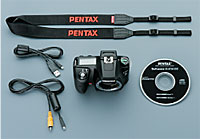
• I-USB17 USB Cable • I-VC28 Video Cable • O-ST53 Strap • ME Finder Cap • Four AA-size alkaline batteries • S-SW55 Software CD-ROM • Eyecup FO • Hotshoe Cover FK
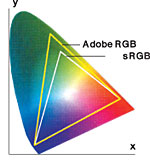
The K100D Super offers two different color spaces — international-standard sRGB and industry-standard AdobeRGB — to accommodate the required data output specifications.


